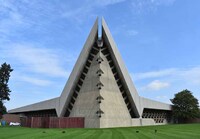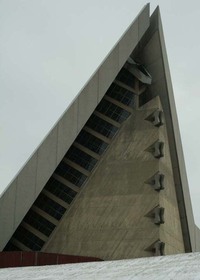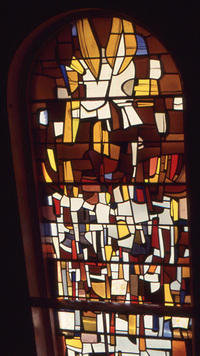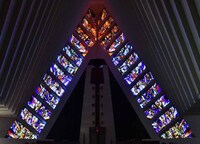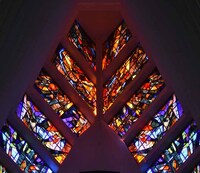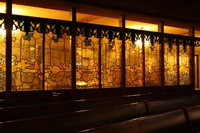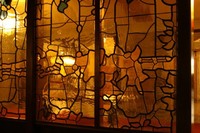MSGC : Featured Windows : Current Window
Featured Windows, March-April 2010
Congregation Shaarey Zedek Artist Robert Pinart
Buildings:
Fountain Street Church - Grand Rapids, Michigan
Congregation Shaarey Zedek - Southfield, Michigan
Metropolitan United Methodist Church - Detroit, Michigan
Congregation Shaarey Zedek in Southfield has been in six earlier locations, but currently, along side the nearby freeway, many are familiar with its very striking architecture. The concrete facade looms at an angle, which makes some wonder how the stained glass windows within that portion of the building have stayed intact since the early 1960’s.
The architects for the building were Percival Goodman (1904-1989) of New York City and Detroit-based Albert Kahn Associates. Kahn Associates was responsible for all the engineering and mechanical aspects.
1
Goodman was a well known architect within the Jewish community, having previously designed buildings for congregations in New Jersey, Pennsylvania, New York, Florida, Minnesota and Oklahoma
2 As mentioned in his New York Times obituary (October 12, 1989)
3 Goodman did not exclusively design synagogues, having been involved with many private homes and public/private schools, mostly in New York, all with modernistic designs.
A variety of artists were chosen for various aspects of artwork and sculpture at Shaarey Zedek but stained glass artist Robert Pinart (1926-) who had collaborated with Goodman on previous synagogues, was selected to design the stained glass windows.
Pinart was born in Paris, loved to draw as a young child and at age seventeen began to take night classes in art which prepared him to study at the well known Ecole des Beaux Arts.
4 Robert received his stained glass training in the studios of three well known French stained glass artists: Max Ingrand (1908-1969), Auguste Labouret (1871-1964)
5 and then he free-lanced with/for Jean Barillet (1912-1997). These studios were involved with restoration of 13th to 17th century windows removed from churches prior to World War II and stored in caves. Because of the scope of deterioration Robert received a foundation of stained glass work which was unusual for such a young person.
6 But Ingrand, Labouret and Barillet were also on the cutting edge of the post-war modernistic art movement in Europe which they, and others, “translated” into stained glass. These efforts picked up momentum immediately after World War II as replacement stained glass windows were needed in war torn areas of Germany, France and England. It was this aspect of his instructors – and the modernist art movement - that greatly influenced the personal artwork and stained glass of Robert Pinart.
By 1951 Pinart had moved to the United States and settled in the greater New York/New Jersey area. He briefly worked for the stained glass firm Payne-Spiers in New Jersey before spending a few years with Rambusch Studios.
7 It was at Rambusch Studios where Pinart gained a background for his future liturgical work. The studio worked on numerous churches and synagogues, and this honed Pinart’s sense of design as he was allowed to decide personally on the width of the lead, the quality of the glass and then he could add the painted details.
8
When Robert began to free lance on his own about 1954, it was so he would have complete control over his work, and could himself meet with the prospective clients. In the interview in
Glass Art, Robert describes collaborative meetings with architect Percival Goodman and Goodman’s wife who was an interior decorator, discussing and deciding - slab glass (dalle de verre) or leaded stained glass – on over a dozen very interesting projects.
When a stained glass artist freelances, he/she needs to find a studio to fabricate the work….a studio with which the artist has an understanding that he/she will make all of the artistic decisions. Robert used Cummings Studio in North Adams, Massachusetts for many years until Cummings closed several years ago.
H.W. (Bill) Cummings recently related several observations of Robert, Cummings Studio having begun to fabricate his work in 1963. Robert was under contract to do several commissions, and Bill was the person to see them through to completion. Bill remembers they did more work in the next two weeks than was humanly possibly…...Robert being the conductor and Bill, the orchestra. Robert’s previous experience in stained glass was such that he did not have to think about
structure, as his designs lent themselves to wonderful structure. Robert’s color sense was magical, and he painted with such ease and fluidity.
9
Bill also feels that Robert “celebrates the freedom of mankind by creative abstract lines of sorrow, or joy, or tension, or release…he then uses color to really bring the thoughts home.” Robert continued to refine his own sense of design, and it is his more recent work with silver stained where Bill feels Robert has brought his work to new heights.
One highlight in Pinart’s career was the ca 1976 invitation to design a window for the Washington National Cathedral in Washington DC -
Founding of a New Nation in the Washington Bay. This led to the second window,
Agony of Civil War directly across the sanctuary in the Lincoln Bay. Both windows are brightly colored, abstract in design
10 and fabricated by Dieter Goldkuhle (b. 1938 Germany) who was (and is) a well known stained glass artist in his own right.
11 These commissions led to several more at the Cathedral
12,13 one of which is a large wall of clear (sometimes called white) reamy glass separating the narthex from the sanctuary.
At least one Michigan church has Pinart windows from this period – Metropolitan United Methodist Church (1926) in Detroit, which was built to hold 3,000 people. This installation was installed in 1982, as noted by the Cummings Studio/Pinart signature, and is a screen running between the sanctuary and the narthex that sits on a waist high wood divider. These windows are constructed with clear, reamy glass, and a “ribbon” of yellow/gold glass runs through (virtually impossible to get a “true” photo!). Rev. Dr. William Quick (pastor emeritus) remembers early discussions that the screen was not to compete with the stained glass windows by Willet Studios.
14 Also remembering the situation, Craig Morrison AIA and a former member of the congregation recalls the selection of Pinart was through Cummings Studio, with whom Morrison had previously worked on an earlier restoration of New York’s state capitol building. The screen at Metropolitan has a similar look/feel to the earlier much larger screen at Washington National Cathedral.
15
Another Michigan Pinart Window is from the Fountain Street Church, Grand Rapids, MI
Another house of worship very proud of their Pinart stained glass windows is Temple Emmanuel in Denver, Colorado, although these 1957 windows are faceted glass
16,17.
More recently, Robert’s work has been fabricated at Wilmark Studio in Pearl River, New York/Shelburne Falls, MA with Mark Liebowitz as the “orchestra”. In the mid 1980’s, Robert designed, selected the glass and painted two large windows for the New City Jewish Center, New City, NY.
18
Another interesting and emotional commission with Wilmark Studio was in Bridgewater, New Jersey at Temple Sholom’s Blumberg Chapel. These windows are a memorial to a young woman in the congregation who died of multiple sclerosis. An article was published in Stained Glass Quarterly, and is reprinted on the Wilmark Studio web site
19,20. (Click on the photos to enlarge them.) Liebowitz relates that as the windows were being revealed for the first time, a severe lightning storm was taking place, which would have rivaled any production by Alfred Hitchcock.
21
Liebowitz recounted he worked with Robert on a whole series of synagogue windows. Among Mark’s favorites are Morristown, NJ; Charlotte, NC; Greenwich, CT; and Kingston, NY. Some of Robert’s more recent work can be seen here.
22
In discussing his own work, Pinart commented that he certainly takes the orientation and lighting of the building into consideration, and that he may make as many as 25 sketches in order to work the design as far as possible, or only make as few as two or three…but will only show a client the best of what he has. He loves to go to Bendheim to choose glass and possibly find a new glass, all the while balancing textures and intensity between his selections.
23
When reviewing Pinart’s work, there are certainly visual stages, one being rather geometric, such as the windows at Shaarey Zedek. This work was more the style being done in Europe after World War II. and with which Robert was very familiar. It is interesting to follow the changes to a more curvilinear design, still very colorful, but with more careful selection of the various hues. Of course, some of this has to do with the availability of glass, and the budget for the commission. According to Mark Liebowitz, Robert would often say "the glass will tell the story," when asked where he was going with a window. He was always looking for something new, to avoid repeating himself. There were times when he would find a special sheet of glass that interested him, perhaps with some striking movement or tonal change and then, he might redraw a section of his cartoon to make the most of the newfound glass.
When the glass was waxed to the easel ready for painting, Robert used the glass as his guide. He let the glass tell him what was needed, and he was completely comfortable trusting his immediate creativity. Robert would often start with the matt, adding depth and movement working with his blenders, scrubs and his fingers. Trace would be added last, to strengthen the composition. Often the fired glass was re-waxed for staining. The stain was often applied on the inside, and he would use a mirror as he didn't want to work backwards.
In 1993 Pinart received the very first Lifetime Achievement Award from the Stained Glass Association of America and has been selected as one of the inaugural ten Senior Advisors for the American Glass Guild.
An interesting side note is Congregation Shaarey Zedek is mentioned in an online list of the “Top Ten Breathtaking Places of Worship.”
24 Bibliography:
Show Bibliography1Ferry, W. Hawkins. The Legacy of Albert Kahn. (Detroit: Wayne State University Press) 1970.
2http://en.wikipedia.org/wiki/Percival_Goodman (accessed February 6, 2010)
3http://www.nytimes.com/1989/10/12/obituaries/percival-goodman-85-synagogue-designer-dies.html (accessed February 6, 2010)
4Waggoner, Shawn. Glass Art Magazine, March/April 1999, pp 54-59 (interview with artist)
5Thanks to Rona Moody, stained glass artist/historian from Scotland and now living in Pittsburgh, PA for the birth/death information.
6Glass Art Magazine, 54.
7http://www.americanglassguild.org/2006%20Conference/Speakers%202006/robert_pinart2.htm (accessed February 6, 2010)
8Glass Art Magazine, 57-59.
9W.H. (Bill) Cummings, e-mail to author, February 4, 2010.
10Crimi, Eoldy and Diane Ney. Jewels of Light: The Stained Glass of Washington National Cathedral. (Washington DC Guidebooks), 2004, pp 57, 65, back cover.
11http://www.bgcmonline.com/BGCM_Gallery/2007-05-21%20National%20Cathedral/slides/037Clemens166.html. (accessed February 6, 2010)
12Jewels of Light, 154, (fig. 141, 142).
13http://www.wilmarkstudios.com/photo%20Commiss/National_Cathedral_Commissions_Photo.html (accessed February 6, 2010)
14Reverend Dr. William Quick, emails to author, January/February 2010.
15Craig Morrison AIA, emails to author, February 2010.
16http://www.emanueldenver.org/, (accessed Feb 6, 2010)
17Faceted glass, also called dalle de verre, is about 1 inch thick and cast in blocks about 8”x 10”; cut with a diamond saw although 50 years ago was cut with a hammer and anvil. The edges can be chipped for additional highlights. The glass is cast in an epoxy matrix with the matrix providing the appropriate negative spaces.
18http://www.wilmarkstudios.com/photo_Synagogue/New_City_Photo.html (accessed February 6, 2010)
19DiCara, Laurie. “A Fitting Memorial in Glass”. Stained Glass Quarterly, Summer 1997, 126-129.
20http://www.wilmarkstudios.com/publications.html (Accessed February 6, 2010)
21Mark Liebowitz, emails to author, January/February 2010.
22http://www.wilmarkstudios.com/photo%20Church/Monastary_Photo.html, (accessed February 6, 2010)
23Glass Art Magazine, 59.
24http://www.examiner.com/x-5674-Detroit-Getaways-Examiner~y2009m4d21-The-United-States-top-10-breathtaking-places-of-worship--6 (accessed February 6, 2010)
Many thanks to Bill Cummings, Mark Liebowitz, Craig Morrison and Reverend Dr. William Quick.(MSGC 2010.0003; 1993.0034; 1992.0057)
Text by Barbara Krueger, Michigan Stained Glass Census, March , 2010.

